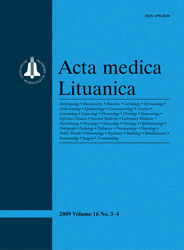 ISSN 1392-0138 ISSN 2029-4174 (online) |
2008 m. Nr. 3 Cross-cultural adaptation and psychometric properties of the Lithuanian version of the Simple Shoulder Test
Background. There are no valid patient-based assessment tools for the shoulder joint in Lithuania. Development of one more new instrument for a small country is unnecessary. This work is not easy and requires considerable investment of both mental and fiscal resources; it will hardly be better than the existing tools and may add more confusion in the literature. The purposes of this study were to perform cross-cultural adaptation of the Simple Shoulder Test (SST) and to test psychometric properties of the Lithuanian version of the Simple Shoulder Test (SST-LT). Materials and methods. The SST was culturally adapted following recommendations of American Academy of Orthopaedic Surgeons. Psychometric properties of the SST-LT were determined for preoperative patient group with rotator cuff injury (n = 108), and for the ambulatory patient group (80 of the 108 preoperative patients) after surgery. Results. The internal consistency in both groups was not high (Cronbach’s alpha 0.722 and 0.844). Intraclass correlation coefficient for test-retest reliability was 0.96 with the 95% confidence interval (0.94–0.98). The SST-LT scores were compared with the Lithuanian SF36v2 and the Constant scoring scale. Correlations between the SST-LT scores, patient-based and observer-based measures were from 0.492 to 0.881 (p < 0.001). Conclusion. The SST-LT can be used as shoulder joint specific and office-based patient selfassessment tool for the Lithuanian speaking population. Keywords: cross-cultural adaptation, Lithuanian version of the Simple Shoulder Test, psychometric properties, rotator cuff tears |
Issues:
2011 - Vol.18 No. 1, No. 2, No. 3, No. 4 2010 - Vol.17 No. 1-2, No. 3-4 2009 - Vol.16 No. 1-2, No. 3-4 2008 - Vol.15 No. 1, No. 2, No. 3, No. 4 2007 - Vol.14 No. 1, No. 2, No. 3, No. 4 2006 - Vol.13 No. 1, No. 2, No. 3, No. 4 2005 - Vol.12 No. 1, No. 2, No. 3, No. 4 2004 - Vol.11 No. 1, No. 2, No. 3, No. 4 2003 - Vol.10 No. 1, No. 2, No. 3, No. 4 2002 - Vol.9 No. 1, No. 2, No. 3, No. 4 2001 - Vol.8 No. 1, No. 2, No. 3, No. 4 |